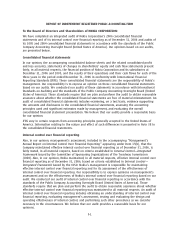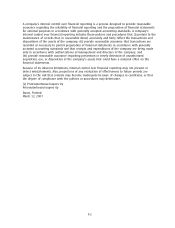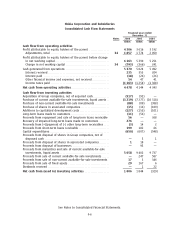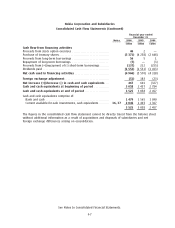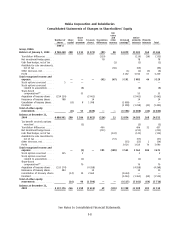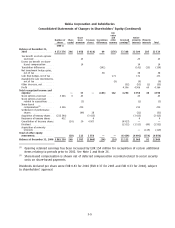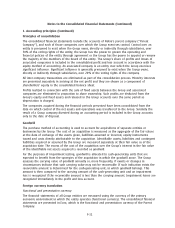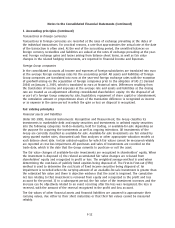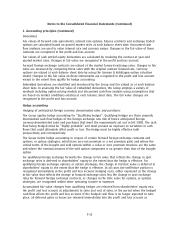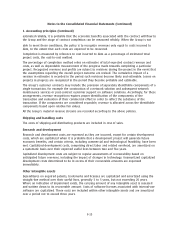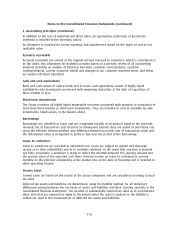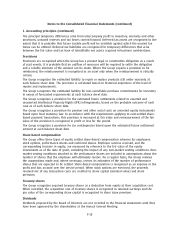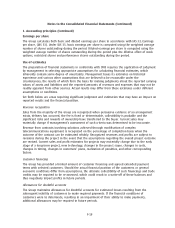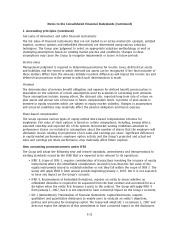Nokia 2006 Annual Report Download - page 146
Download and view the complete annual report
Please find page 146 of the 2006 Nokia annual report below. You can navigate through the pages in the report by either clicking on the pages listed below, or by using the keyword search tool below to find specific information within the annual report.Notes to the Consolidated Financial Statements (Continued)
1. Accounting principles (Continued)
Principles of consolidation
The consolidated financial statements include the accounts of Nokia’s parent company (‘‘Parent
Company’’), and each of those companies over which the Group exercises control. Control over an
entity is presumed to exist when the Group owns, directly or indirectly through subsidiaries, over
50% of the voting rights of the entity, the Group has the power to govern the operating and
financial policies of the entity through agreement or the Group has the power to appoint or remove
the majority of the members of the board of the entity. The Group’s share of profits and losses of
associated companies is included in the consolidated profit and loss account in accordance with the
equity method of accounting. An associated company is an entity over which the Group exercises
significant influence. Significant influence is generally presumed to exist when the Group owns,
directly or indirectly through subsidiaries, over 20% of the voting rights of the company.
All intercompany transactions are eliminated as part of the consolidation process. Minority interests
are presented separately in arriving at the net profit and they are shown as a component of
shareholders’ equity in the consolidated balance sheet.
Profits realized in connection with the sale of fixed assets between the Group and associated
companies are eliminated in proportion to share ownership. Such profits are deducted from the
Group’s equity and fixed assets and released in the Group accounts over the same period as
depreciation is charged.
The companies acquired during the financial periods presented have been consolidated from the
date on which control of the net assets and operations was transferred to the Group. Similarly the
result of a Group company divested during an accounting period is included in the Group accounts
only to the date of disposal.
Goodwill
The purchase method of accounting is used to account for acquisitions of separate entities or
businesses by the Group. The cost of an acquisition is measured as the aggregate of the fair values
at the date of exchange of the assets given, liabilities assumed or incurred, equity instruments
issued and costs directly attributable to the acquisition. Identifiable assets, liabilities and contingent
liabilities acquired or assumed by the Group are measured separately at their fair value as of the
acquisition date. The excess of the cost of the acquisition over the Group’s interest in the fair value
of the identifiable net assets acquired is recorded as goodwill.
For the purposes of impairment testing, goodwill is allocated to cashgenerating units that are
expected to benefit from the synergies of the acquisition in which the goodwill arose. The Group
assesses the carrying value of goodwill annually or, more frequently, if events or changes in
circumstances indicate that such carrying value may not be recoverable. If such indication exists the
recoverable amount is determined for the cashgenerating unit, to which goodwill belongs. This
amount is then compared to the carrying amount of the cashgenerating unit and an impairment
loss is recognized if the recoverable amount is less than the carrying amount. Impairment losses are
recognized immediately in the profit and loss account.
Foreign currency translation
Functional and presentation currency
The financial statements of all Group entities are measured using the currency of the primary
economic environment in which the entity operates (functional currency). The consolidated financial
statements are presented in Euro, which is the functional and presentation currency of the Parent
Company.
F11


